Today we woke up early, grabbed some breakfast, and set off into the field in search of a good sampling location. On the east side of town is a road that extends toward the Coppermine River and the town’s pump house. The goal for the day was to find a location where we could easily collect water samples that were representative of the geochemistry of the entire river. Geochemistry combines chemistry and geology to better understand the major mechanisms that direct geological systems.
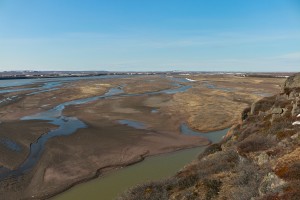
Despite the pump house being easy to access, we decided to walk on in search of a better location. To our left the hill descended quickly to the valley floor. The river widened as it flowed into the bay. Tiny purple flowers and willow bushes began to open their petals and leaves to the sunlight. We ascended the red-rock hill in front of us and the view of the valley floor opened up below. A large sandbar extended from the bottom of the cliff toward the river. No easy path presented itself through the marsh so we decided to head back to town and await our meeting with the HTO Board of Directors.
We arrived at the Hunter and Trapper Organization (HTO) headquarters and sat down in their boardroom for our meeting. Barb made a pot of coffee for us in the background as individuals from Kugluktuk started to arrive. Several people showed up to our meeting – two men, Christian and Jorgan, who will collect the water samples, Fredd and Kevin volunteered as our wildlife monitors, and David was the head of the board. After introductions, Matt Alkire began to describe the project to the group.
The group had many questions for us. Why did we want water samples from the Coppermine River? What effect might this study have on the local community? How did we envision the HTO helping with this project?
Matt, Greg, Rob and I responded to each of the group’s questions and this appeared to put them at ease and they seemed excited for the project too. We also had many questions for the board. The people of Kugluktuk have observed many changes in their town with the weather, climate, and timing of events. These anecdotal changes provide a picture of an ecosystem that is rapidly changing and unpredictable. They emphasized that it is very important to them to see the Coppermine River protected and they want to better understand the changes occurring in Kugluktuk.
We settled on a plan to meet tomorrow and take a boat up-river to find a nice sampling site that Christian and Jorgan will be able to access for the remainder of the summer. The group went outside and we started to prepare a boat for the trip. While we checked over the engine there was a part that was disconnected and laying underneath the engine block. With any luck this is not an important part – regardless we will find out soon…. After the boat was ready for the morning we headed back to the Inn.
Before dinner we decided to go check out the Co-Op, a grocery store/hardware store with many other general items. I had been forewarned that certain foods can be much more expensive in the Nunavut, but I was humorously surprised by what I discovered. Are you hungry for some milk and cookies? That will be $16.00 (Chips Ahoy = $9.99 and 1 Qt Milk = $6.00).

How about a bag of Cool Ranch Doritos and a 12-pack of soda? That will only cost you about $32.00 ($7.99 for Doritos and $24.00 for the soda). I quickly slimmed down what items I wanted to only items that I “needed” – you know, items such as bananas, Snyders pretzels, and some candy worms. This only set me back $14.00 – not too bad in my opinion. I walked back to the Inn munching happily on my snacks. Over the hill behind the Inn the sky started to grow dark.

As we walked closer there was a flash of lightning in the distance. Kids continued to climb un-phased on the rocks on the west side of town. According to the owners of the Inn and everyone at the HTO, it is extremely rare to have a thunderstorm in June.
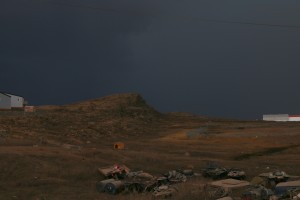
We waited out and began taking pictures of the incoming cloud cover. The sky turned a mild shade of gray and green and continued to roll toward town from the southwest. Just before dinner the storm was on top of the Inn dumping buckets of rain. The temperature outside dropped and hovered around 40 degrees Fahrenheit. Nadene explained that the past couple of years there have been one or two storms like this earlier in summer, but that this phenomenon is recent and often unpredicted.
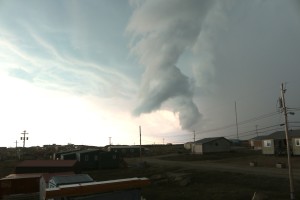
Many elders in Kugluktuk do not recall ever having to worry about a thunderstorm in the summer growing up. It is unclear what factors are leading to these changes in weather patterns; however, climate change is predicted to cause more-frequent storms and significant weather events in the future. This could become the new normal for Kugluktuk.
The storm passed overhead and faded into the distance. By this time it was almost 8:00 pm, but with twenty-four hours of daylight I decided to go outside to take some pictures. I climbed to the top of the hill overlooking the town.
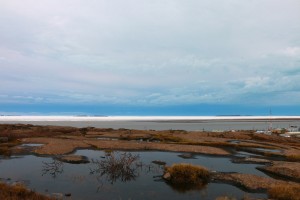
To the north the storm was quietly sending rain down on the bay. Large sheets of ice still covered most of the bay. Pools of water collected over the smooth, red metamorphic rock that forms the hill west of town.
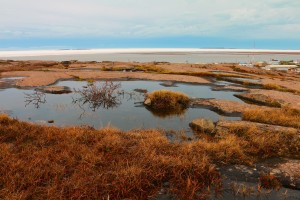
Dispersed around the rocks are layers plants and organic matter that have accumulated in this harsh environment over many years. Adults and children on four-wheelers (they are called ‘quads’ in Kugluktuk) cruise around town un-phased by the recent abnormal weather. A rugged dog stands firm at his post.
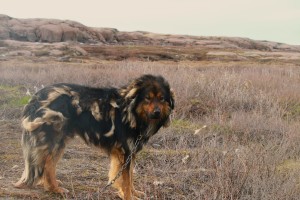
In the Bay fishermen checked their nets for Arctic Char.
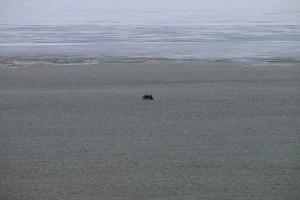
This project has the opportunity to fill in significant gaps in scientific knowledge about the Arctic Ocean and the contributions of small Canadian rivers to the overall volume of freshwater entering the Arctic Circle. The data for climate change has spoken – the earth is warming and our actions have directly contributed to this increase. We are still discovering the extent of these changes and their effects on ecosystems. The remaining ice in Coronation Bay continued to float under the unseasonal storm on the horizon, oblivious to the changes occurring around it. One thing is clear to me – this project and others that are searching to understand these changes cannot happen fast enough.
